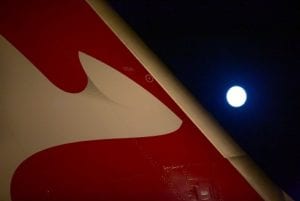 A 14-year-old high school student, a crown prosecutor, an amateur photographer and a 90-year-old former Qantas flight attendant were among the 180 passengers on board QF1250, the Qantas supermoon scenic charter flight that took to the skies above Sydney, Australia to view a rare double phenomenon of a supermoon and full lunar eclipse.
A 14-year-old high school student, a crown prosecutor, an amateur photographer and a 90-year-old former Qantas flight attendant were among the 180 passengers on board QF1250, the Qantas supermoon scenic charter flight that took to the skies above Sydney, Australia to view a rare double phenomenon of a supermoon and full lunar eclipse.
The B787-9 Qantas Dreamliner departed from Sydney Airport at 7:30pm and climbed to a cruising altitude of more than 40,000 feet over the Pacific Ocean away from city lights for the three-hour tour.
As the aircraft began its specially designed flight path in preparation for the celestial show, passengers enjoyed “supermoon cakes” and cosmic cocktails, while CSIRO astronomer Dr Vanessa Moss provided expert insights into the science behind supermoons and lunar eclipses.
The total lunar eclipse began at 21:11 AEST. During this time, the pilots dimmed the cabin lights as the moon crossed into the darkest part of the Earth’s shadow, and passengers experienced totality for 14 minutes and 30 seconds. This total eclipse was relatively short because the Moon was only passing through a small section of the Earth’s umbra.
Fourteen-year-old Matilda travelled with her parents from Brisbane for the flight. A Qantas media release described how The STEM student was scheduled to attend a NASA space camp in Alabama, USA this year before COVID-19 thwarted those plans. She said the Qantas supermoon scenic flight was an exciting alternative in the meantime.
“Being able to see the supermoon up close was amazing and hearing from Dr Moss was awesome. I hope I can come on a future Qantas Moon chasing flight and be the astronomer that teaches everyone how cool space and science are,” Matilda said.
Qantas Chief Technical Pilot, Captain Alex Passerini, said the biggest challenge with flying the supermoon scenic flight was the variables of weather and air traffic, as well as coordinating the  optimum flight route in consultation with CSIRO and Air Services Australia.
optimum flight route in consultation with CSIRO and Air Services Australia.
“We had designated airspace set aside for us around 465 kilometres off the coast of Sydney and we mapped out the flight path based around the trajectory of the Moon rising and the timing of the total eclipse.
“We executed a series of turns to ensure passengers on both sides of the aircraft got great views of the moon at various times.”
Australia will have to wait another 12 years for the next supermoon and total lunar eclipse combination which will take place on 8 October 2033.
The Qantas Supermoon Scenic Flight operated with net zero emissions, with 100% of carbon emissions offset.
This flight is the latest in a series of special flights Qantas has operated in the past 12 months.
Edited by Peter Needham















